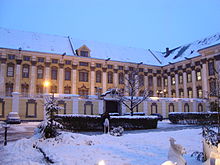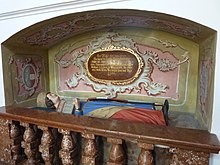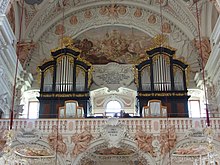Garsten Abbey

The Garsten Abbey is a former Benedictine - Abbey in Garsten in Austria . Today the Garsten prison is located in the former monastery buildings .
history
The monastery was founded in 1082 by Otakar II as a secular canon monastery and house monastery (also burial place); it served the Traungauers next to the Styraburg as a pivot of their rule.
From 1107 it was a Benedictine priory ( dependent on Göttweig ) and from 1110/11 an independent abbey in the Diocese of Passau . The monastery became known through its first abbot, Berthold von Garsten .
Since 1490, under Friedrich III. , the area belongs to Austria above the Enns . A structural renovation was carried out from 1677 by the Carlone family, who first rebuilt the church and then began building the new monastery. From 1708 to 1726 the construction of the monastery complex was continued by Jakob Prandtauer . Since 1784 Emperor Joseph II forced the Diocese of Passau to renounce its parishes in Upper and Lower Austria, it belonged to the Diocese of Linz .
In 1787 the abbey was closed by Emperor Joseph II .
For a long time Garsten was the religious, cultural and spiritual center of the Eisenwurzen . The high medieval tradition books of the monastery, which combine brief records on the history of ownership (for example on the transfer of land or people), descriptions of legal disputes and historiographical notes, are partially preserved .
Engraving by Georg Matthäus Vischer from 1674
Possessions
Even as a foundation endowment, it received important property in the Traisen and Gölsental in Lower Austria , probably from the dowry of the founder's wife, Elisabeth, a daughter of the Babenberger Leopold II .
The Steyrer Traungauer, who had developed the Mark on the Mur , increasingly moved to the Graz area at the beginning of the 12th century and formed today's Styria. After 1138, Sophie , the widow of Leopold I the Strong and regent for Ottokar (III of Styria) , bequeathed the entire Gaflenz estate , which had become her own as a morning gift , to the monastery. Thus was Gaflenz , originally a branch of Waidhofen an der Ybbs , within the limits Neustiftergrabenbach / Bischofsberg and Frenz Bach elevated to parish. In 1151, Bishop Konrad I von Passau exchanged his tithing claim to Gaflenz with Garsten.
Numerous parishes in the Enns and Steyrtal valleys were dependent, such as Molln : Above the portal of the rectory, which was completed in 1734, are the coats of arms of the Garsten monastery and the abbot Konstantin . But the influence also extended beyond that: from 1163/67 the parish church of St. Magdalena in Linz was Garstner's own church . In Vienna Nussdorf the monastery owned a vineyard and in nearby Heiligenstadt a bathing establishment.
Collegiate church
The collegiate church and today's parish church Garsten was built by the master builder family Carlone and is one of the most beautiful buildings of the high baroque in Austria. The stucco work and tapestries of Dutch origin, which are draped in the Advent and Lent season with the Lent cloths designed by Kremser Schmidt , deserve special mention . The Losensteiner Chapel (burial place of the Losensteiners ), the sacristy and the summer choir are particularly worth seeing .
Todays use
A penal institution has been located in the buildings of the former monastery since 1851 . The Garsten Prison is one of the few prisons in Austria in which life sentences are served. The former collegiate church serves as a parish church.
Berthold organ
In the course of the general renovation of the church, the Berthold organ was also renewed. From the old church organ, only the two 100-year-old organ cases could be reused, everything else was newly planned and built by Rudolf von Beckerath Orgelbau GmbH. On July 14th, 2009 the first organ parts from Hamburg were brought to Garsten for assembly. The consecration of the Berthold organ on December 8, 2009 marked the end of the extensive renovation of the baroque church.
List of abbots from 1444
- Adalbert, officiated as abbot 1444–1461
- Berthold IV, officiated as abbot 1461–1473
- Benedict, officiated as abbot 1473–1488
- Leonhard II. Knieschenk, officiated as abbot from 1488–1493, was murdered
- George I, officiated as abbot 1493–1495
- Ulrich V. Pranauer, officiated as abbot 1495–1524
- Pankraz Halzner, officiated as abbot 1524–1537
- Wolfgang Granfuß, officiated as abbot from 1537–1559
- Prundorfer, officiated as abbot 1559–1568, was deposed
- Georg Lachmayr, officiated as abbot from 1568–1574, was previously abbot in Gleink
- Johann Spindler, officiated as abbot 1574–1589, then became abbot in Kremsmünster
- Vacancy 1589–1591, administration by Prior Michael Angerer, later Abbot in Baumgartenberg
- Martin Alopitius, officiated as abbot 1591–1599, then became abbot of St. Lambrecht
- Alexander a Lacu, served as abbot 1600–1601
- Johann Wilhelm Heller, officiated as abbot 1601–1614
- Anton Spindler, officiated as abbot 1615–1642, was then Abbot of Scots in Vienna
- Roman Rauscher, from Hall in Tirol, lived January 29, 1604 - October 12, 1683, professed 1624, Primiz 1629, professor of philosophy at the University of Salzburg, subprior 1639, prior 1640, officiated as abbot 1642–1683
- Anselm Angerer, from Steyr, lived March 31, 1647 - April 29, 1715, professed in 1665, ordained priest in 1672, subprior in 1680, rector of the University of Salzburg, officiated as abbot 1683–1715
- Ambros von Freudenpichl, from Oberndorf in Styria, lived 1679 - December 22, 1729, professed in 1696, ordained priest in 1703, professor in Salzburg, subprior, officiated as abbot 1715–1729
- Konstantin Muttersqual, from Freiling, lived May 25, 1685 - May 13, 1747, professed 1705, ordained priest in 1710, conductor 1715, prior 1727–1730, officiated as abbot 1730–1747
- Leopold Till, from Scheibbs, lived June 14, 1688 - June 16, 1757, joined 1710, professed 1711, ordained priest in 1715, 1737 parish priest of Steyr, officiated as abbot 1747–1757
- Paul Meyer, from Lauterbach near Inzersdorf in the Kremstal, lived December 12, 1721 - October 30, 1763, entered 1741, ordained a priest in 1745, served as abbot from 1757–1763
- Maurus Gordon, from Weyer, lived November 24, 1726 - December 17, 1786, entered 1745, professed in 1746, ordained priest in 1750, officiated as abbot 1764–1786, last Abbot from Garsten, from 1784 also administrator of the dissolved Gleink monastery, 1787 dissolution of monastery Cooked.
See also
literature
- Heinz Dopsch : The Styrian Otakars About their origins and their dynastic connections. In: Gerhard Pferschy (Ed.): Becoming of Styria. The time of the Traungau. Festschrift for the 800th return of the elevation to the duchy. Publishing house Styria, Graz u. a. 1980, ISBN 3-222-11281-9 (publications of the Steiermärkisches Landesarchives, Volume 10), pp. 75-139.
- Siegfried Haider : Studies on the traditional books of the Garsten Monastery (= communications from the Institute for Austrian Historical Research . Supplementary volume 52). Oldenbourg, Munich 2008, ISBN 978-3-486-58553-7 .
- Siegfried Haider (arr.): The traditional documents of the Garsten monastery. Critical Edition (= source editions of the Institute for Austrian Historical Research . Volume 8). Böhlau, Vienna 2011, ISBN 978-3-205-78664-1 .
- Siegfried Haider: To the Garstener abbot series in the 12th century. In: Yearbook of the Upper Austrian Museum Association. Volume 149a, Linz 2005, pp. 309-326 ( PDF on ZOBODAT ).
- Karl Krendl: "... and got engaged here". Pilgrimages in the former Garsten Abbey and its parishes. Linz 2011, ISBN 978-3-902330-59-8 .
- Franz Xaver Pritz : History of the former Benedictine monasteries Garsten and Gleink, in the country above the Enns, and the parishes belonging to them. Haslinger, 1841 ( Google eBook, full view )
- Historical Provincial Commission for Styria, Institute for History - Karl-Franzens-Universität Graz (Ed.): Document book of Styria . Volume I From the beginning to 1192. ( Recipient: Garsten, GA5 , index of documents).
- Gottfried Edmund Frieß : History of the Benedictine monastery Garsten in Upper Austria. In: StMBO III / 2, 1882, pp. 241-248.
- Wolfgang Huber, Huberta Weigl (eds.): Jakob Prandtauer (1660–1726). Planning and building for the service of the Church. Exhibition catalog, St. Pölten 2010, pp. 115–120.
Web links
- Abbot list: http://www.benediktinerlexikon.de/wiki/Garsten/Äbte
- Garsten Abbey: New results for the hall and stairwell
Individual evidence
- ↑ Franz Xaver Pritz: History of the Styrian Ottokare in their ancestors, up to the extinction of this tribe in 1192. 1844 ( In an anthology, p. 289 f., Google eBook, complete view )
- ↑ Bishop Konrad I of Passau gives abbot Sirus von Garsten his tenth share in the parish of Gaflenz by way of exchange , gams.uni-graz.at (pdf)
- ↑ Pfarre Molln ( Memento of the original from February 3, 2014 in the Internet Archive ) Info: The archive link was automatically inserted and not yet checked. Please check the original and archive link according to the instructions and then remove this notice. (accessed on March 16, 2011)
- ↑ On the trail of the Garstner monks (accessed on March 16, 2011)
- ↑ Archived copy ( Memento of the original from August 15, 2011 in the Internet Archive ) Info: The archive link was automatically inserted and not yet checked. Please check the original and archive link according to the instructions and then remove this notice.
Coordinates: 48 ° 1 ′ 11 ″ N , 14 ° 24 ′ 37 ″ E




